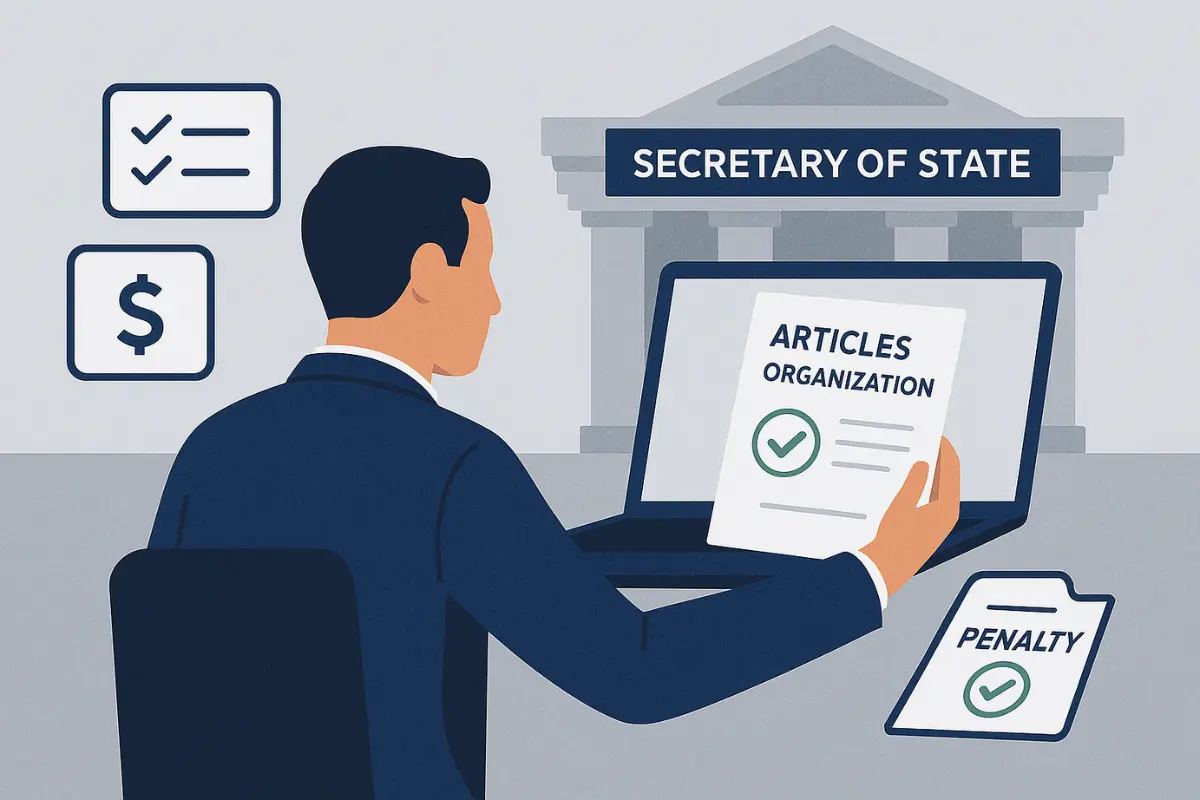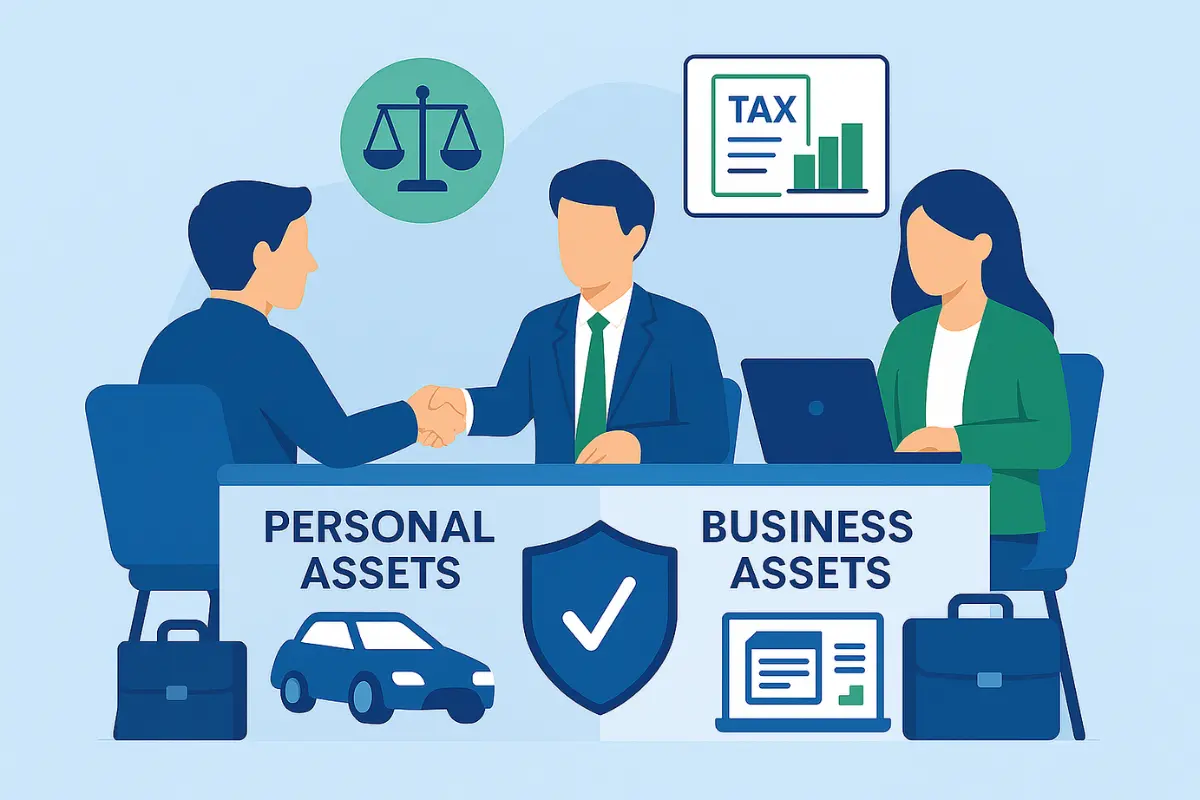Separating Business and Personal Assets Step by Step

Many business owners aren’t aware that blending personal and business finances can put everything from their home, savings and investments at risk if their company runs into legal trouble. Too often, freelancers, entrepreneurs and small business owners blur these lines without realizing it, leaving themselves exposed in ways that may only become obvious when it’s too late.
If your business faces a lawsuit, creditor claim or tax complication, and your finances aren’t clearly separated, your personal assets could be on the line. Mixing business and personal finances can mean losing your liability protection, potentially leaving you personally responsible for debts or lawsuits that could have been easily avoided.
Luckily, sorting this out doesn’t have to be daunting or expensive. You don’t need a team of accountants or attorneys to get on the right track. This practical, step-by-step guide will walk you through exactly how to establish these financial boundaries, so you can protect your assets, simplify tax season and ensure your business has the credibility it deserves from day one.

Key Takeaways
-
Proper separation of business and personal assets safeguards your personal wealth from business risks while ensuring compliance with legal and tax requirements
-
Asset separation involves both legal structure and consistent daily practices: forming an LLC or corporation is just the start, you must diligently maintain separate finances, accounts and records to preserve liability protection
-
Never commingle funds by using personal accounts for business transactions or vice versa. Doing so can pierce the corporate veil, that is, remove your business’s legal protection, and put your personal assets at risk from business creditors and lawsuits
-
Maintaining separate bank accounts, accurate bookkeeping and professional financial practices boosts your business credibility with lenders, clients and business partners. Always distinguish personal from business expenses to keep clean, compliant records
Step 1: Choose the Right Legal Business Structure
Separating your personal and business assets starts with selecting a formal business entity that creates legal boundaries between you and your company. According to the U.S. Small Business Administration, "The business structure you choose influences everything from day-to-day operations, to taxes and how much of your personal assets are at risk. You should choose a business structure that gives you the right balance of legal protections and benefits."
Sole Proprietorships (for one owner) and General Partnerships (for two or more owners) are the default business entities when you don't register with the state. These structures offer no liability protection. Legally, there is no separation between the owners and the business; they are considered the same legal entity. This means any debts or lawsuits involving your business can put your personal assets directly at risk.
When you register a formal business structure with the state, your business becomes a separate legal entity, distinct from its owners. This means any debts, obligations or lawsuits involving the business are directed towards the business itself, not the owners. As a result, you now have liability protection, creating a barrier that helps protect your personal assets from business liabilities.
Here are some of the most common business entities that offer personal liability protection:
-
Limited Liability Companies (LLCs)
-
C Corporations (C Corps)
-
S Corporations (S Corps)
-
Limited Liability Partnerships (LLPs)
When choosing the best business structure for your situation, consider your liability exposure, tax preferences and long-term goals.
Step 2: Register Your Business With the State
Legally registering your chosen business entity transforms it into a separate legal entity. This process involves filing formation documents, such as Articles of Organization (for LLCs) or Articles of Incorporation (for corporations), with the appropriate state agency, typically the Secretary of State. When forming your company, you will also need to pay a filing fee and appoint a registered agent, who is responsible for receiving important legal documents on behalf of your business.
Selecting your business name is an important part of registration. Choose it strategically, as this name will appear on all official documents and business accounts that help maintain the separation between your personal and business finances.
The registration process varies by state but generally takes 1–2 weeks to complete and costs between $50 and $500. It is often required before you can open business bank accounts or apply for any necessary licenses to operate legally.

Step 3: Obtain an Employer Identification Number (EIN)
An Employer Identification Number (EIN) serves as the equivalent of your business's Social Security number, creating a unique identifier that separates your business entity from your personal tax identification.
Your EIN enables you to open business accounts, file separate tax returns and hire employees under your business entity rather than your personal name. Banks require an EIN to open business accounts, and the IRS uses it to track your business income separately from your personal income.
You can apply for an EIN for free through the IRS website or use a third-party company to assist with EIN application and related filing processes, often as part of comprehensive business formation services.
Obtaining your EIN is a crucial step in legally separating your business finances from yourself in the eyes of the IRS and financial institutions.
Step 4: Open a Dedicated Business Bank Account
Opening a separate business checking account creates the most critical financial boundary between your personal and business finances. Additionally, it can help you monitor the financial health of your business. Use your EIN and formation documents to open the account in your business's legal name.
Do not mix your personal and business finances. Establish a strict rule: no personal expenses paid for from the business account, and no business revenue deposited into personal accounts. This prevents commingling funds, which can pierce the corporate veil and expose your own assets to lawsuits or business creditors.
As TaxAct explains, "By separating your business and personal finances, you can keep track of your expenses, income, and profits more accurately. This can help you with organization and streamlining your recordkeeping, which will be especially helpful during tax season. In addition, keeping your personal and business accounts separated will provide you with much-needed personal legal protections, which can safeguard your personal assets in case of lawsuits or other legal issues."
Set up automatic transfers for regular business expenses like internet service and merchant services. This creates documentation showing consistent business operations separate from your personal checking account activities.
Step 5: Get a Business Credit Card or Line of Credit
A business credit card creates another layer of financial separation while also building your company's independent business credit. Apply using your EIN, rather than relying on your personal credit history.
Always use separate credit cards for business and personal transactions. Never use personal credit cards for business expenses and vice versa. Doing so, even temporarily, can risk piercing the corporate veil and jeopardize your liability protection.
Be sure to use your business credit card responsibly: put business purchases on your business credit card and pay the balance from your business bank account. This keeps your business and personal accounts clearly separated and helps establish a business credit score. Building business credit not only simplifies accounting but also helps your company qualify for loans and demonstrates that your business operates as a legitimate, separate legal entity.
Step 6: Establish a Formal Bookkeeping System
Professional bookkeeping creates the detailed financial records necessary to maintain asset separation and protect your business's legal status. Choose accounting software, like QuickBooks, or hire a CPA to systematically track all business income and expenses.
Maintain detailed records of every business transaction with supporting documentation. For example, keep receipts for office supplies as business expenses and make sure each is tracked separately from any personal purchases. This proves your business expenses are legitimate and not for personal use. Never use business funds for personal purposes without proper documentation.
Decide whether cash or accrual accounting works best for your business and stick to it consistently. Accurately record owner draws to show how you compensate yourself from business profits. For LLC owners, document draws as distributions, not informal withdrawals, to avoid the appearance of commingling business and personal funds.
According to Lewis CPA, "a business can do everything right and still be subject to an IRS audit, as many already know. In this case, bookkeeping helps. Your business return makes claims and representations, and the audit aims at verifying them. Good bookkeeping is all about connecting the dots between those representations and reality. When auditors can follow the information on a ledger to receipts, bank statements, and pay stubs, to name a few documents, they quickly learn of the competency and integrity of the business organization."
A formal, dedicated bookkeeping system and strict financial separation are crucial to help you avoid audits or legal challenges, even if your business entity is set up correctly.
Step 7: Pay Yourself a Salary or Draw, Not Personal Withdrawals
Establish a consistent method for paying yourself that clearly separates personal finances from business operations. If your business is an S-Corp or C-Corp, use payroll to pay a regular salary. For LLC owners, take owner draws on a set schedule. Avoid randomly withdrawing money for personal expenses, as this blurs legal boundaries and risks piercing the corporate veil.
Document every payment with clear records to demonstrate formal compensation. If you need emergency funds, handle them as a formal loan with written repayment terms to maintain proper financial separation.
This formal approach protects your legal status by showing that the business and personal finances remain distinct and professionally managed.
Step 8: Maintain Corporate Formalities and Documentation
To maintain their separate legal status and protect owners from personal liability, formal business entities must meet certain legal and operational requirements. LLCs typically maintain updated operating agreements, document major business decisions and keep detailed records. Depending on the state, they may also be required to file annual reports, and in some cases, hold annual meetings and record meeting minutes.
Corporations have stricter mandates: they must maintain bylaws, hold annual shareholder and board meetings with documented minutes, properly issue stock and file annual reports with the state. These formalities are legally required and crucial to preserve corporate status.
These formalities provide important evidence that courts look for in asset protection cases. Observing these practices helps demonstrate your business operates independently, protecting your limited liability and reducing the risk of personal liability through piercing the corporate veil.
Step 9: Purchase Appropriate Business Insurance
Business insurance provides additional asset protection beyond the legal separation created by your business entity. General liability insurance protects against customer injuries and property damage that could threaten both business assets and personal property.
Obtain adequate coverage based on your business risks. Consider professional liability and commercial property insurance to cover specific risks. Appropriate insurance coverage can help protect you against lawsuits, accidents or claims. Never rely solely on personal insurance for business activities; separate policies reinforce the legal and financial distinction between personal and business assets.
Step 10: Work With Legal and Financial Advisors
Professional guidance ensures your business is set up correctly and helps keep your personal and business assets separate. Business attorneys can help you choose the right structure, and an accountant will make sure your methods support your separation goals and optimize tax deductions.
Regular consultations help you adapt your practices as your business grows. Getting legal advice is especially important if your business setup is more complex or you operate in more than one state. The cost of professional advice is minimal compared to the potential consequences of inadequate asset separation.

Step 11: Avoid Commingling Funds at All Costs
Commingling personal and business funds is the biggest threat to your liability protection and can have serious legal implications. Mixing personal assets with business finances can lead to courts piercing the corporate veil, exposing you to unlimited personal liability.
Never pay personal bills from business accounts or deposit personal income into business accounts. Using business credit cards for personal expenses also risks losing legal protections.
Keeping your personal finances separate from business operations is critical to maintaining liability protection and shielding your personal assets from business creditors.
Step 12: Keep Personal and Business Contracts Separate
Always sign contracts, leases and agreements in your business's legal name using your official title, not your personal name. This includes vendor, office space, subscriptions and client contracts.
Using your business's name clearly shows third parties that the company, not you personally, is responsible, which helps maintain legal separation. Use business letterhead and ensure the correct entity name appears on all documents to reinforce your business's separate status.
Step 13: Stay Compliant With Taxes and State Filings
File separate tax returns if required by your business structure. Pay estimated taxes quarterly based on your business income. Use business funds to pay business taxes and personal funds for personal taxes to maintain proper separation.
Keep up with annual state filings and franchise taxes to stay in good legal standing. Maintain detailed records showing your business operates independently with separate tax obligations.
Staying current with tax and legal requirements is essential; lapses in compliance can cause you to lose the liability protections your business entity provides.
Work with a tax professional to ensure your tax status supports your separation goals and maximizes income tax benefits.
Start Separating Your Assets Today!
Separating your personal and business assets is not just a legal requirement; it's a smart financial strategy. Proper separation protects your personal wealth, simplifies your accounting and strengthens your business credibility. Every day you wait to put the proper protocols in place increases your risk of personal liability from unexpected business debts or lawsuits. If you haven't yet set up the right business structure, professional guidance can streamline the process and help you avoid costly mistakes.
FAQs
Can I use my personal savings to fund my business at the beginning?
Yes, you can fund your business with personal savings, but document the transaction properly. Record it as a capital contribution or loan, then transfer funds into your business bank account first. Never pay business expenses directly from your personal bank account, as this creates commingling issues that expose personal assets to business creditors and can compromise your tax status.
What happens if I accidentally mix personal and business funds once or twice?
While occasional mistakes may not automatically dissolve your liability protection, repeated or careless commingling can weaken your legal standing. If this happens, correct the errors immediately with clear documentation and consult your accountant to ensure the transactions are properly categorized. Courts and the IRS examine patterns, so isolated incidents properly addressed typically won't eliminate your asset protection. However, consistent mixing shows you don't treat your business as a separate entity.
Do I need to separate assets if I'm a freelancer or sole proprietor?
Even though sole proprietorships don't provide liability protection like limited liability companies, you should still separate your finances. Separate bank accounts simplify tax preparation, keep finances organized and help create professional credibility. Maintaining separate finances can also help prepare you for transitioning to a more formal entity like an LLC.
How can I prove to the IRS or a court that my business is truly separate from me personally?
Proof comes from consistent, documented behavior showing you treat your business as a separate entity. This includes maintaining separate business accounts, using your EIN, signing contracts and issuing invoices in the business's name, keeping detailed financial records, following entity formalities like annual filings and never commingling personal and business expenses. Courts and the IRS look for evidence that your business operates independently with its own financial identity separate from your personal affairs.
Is it illegal to commingle business and personal funds?
Commingling business and personal funds is not usually illegal by itself, but it's a risky practice that weakens liability protection and can cause tax problems. For LLCs and corporations, commingling can lead to loss of personal liability protection if a court "pierces the corporate veil." In regulated professions, it may be explicitly illegal and result in severe penalties. To protect yourself and your business, always keep finances separate.
Need Help Establishing Your Business Entity?
Ready to take the first step? InCorp's business formation experts are here to help you establish your business entity so you can build the protection and credibility your business deserves. Contact us today and let InCorp help secure your business's legal protection and financial future.
Share This Article:
Stay in the know!
Join our newsletter for special offers.